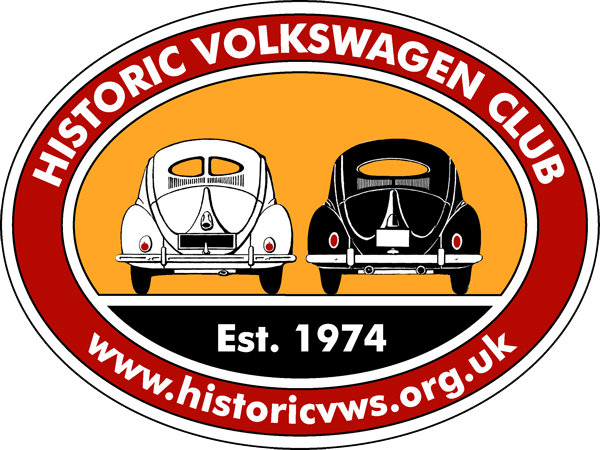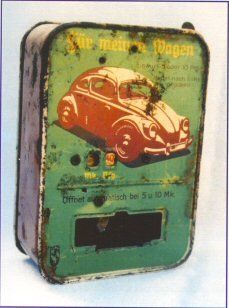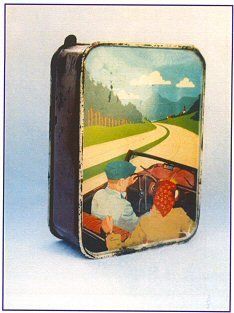The KdF-Wagen Savings Boxes
by Brain Screaton
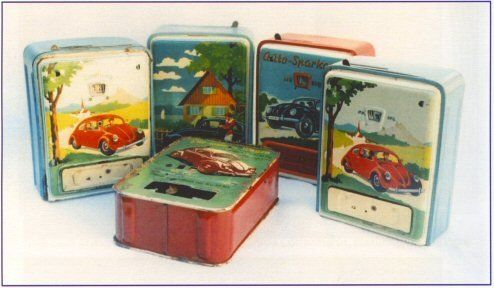
Apart from a short piece in the May 2001 edition of the VW Model Club magazine, I have never seen another article on these delightful pieces of KdF-Wagen memorabilia, so as I am fortunate enough to have access to the five examples pictured above, I thought that, after a bit of research, I would tell you as much as I can find out about them. I am not by any stretch of the imagination an expert - I am sure that there are other Club Members who know far more about these items than me, but nevertheless, here goes.
The purpose of the Savings Boxes was of course to encourage the German public to save up and buy their own Volkswagen, or 'KdF-Wagen', as it was renamed by Hitler in 1938. Pre-production KdF-Wagens were despatched on publicity tours throughout Germany and Austria to generate interest, and brochures and application forms were handed out. The car was to be sold through a Savings Scheme, or 'Sparvertrag', and the first rung on the savings ladder was to post your 5 and 10 pfennig pieces into your KdF-Wagen Savings Box. You put your coin in the slot at the top, pushed the lever, and the coin would fall into the box. At the same time a counter on the front would advance by the appropriate amount (the mechanism could differentiate between 5 and 10 pfennings)
When either 5 or 10 Reichsmark had been saved, a small panel on the front would pop open, and you would then rush down to the local KdF-Wagen Savings Office to buy one or two stamps (depicting the car), to stick on your Savings Card. To get a car, you had to save RM990, or RM1190 with insurance, so it took a lot of 5 and 10 pfennigs! In reality, of course, no-one ever got their car, due to the War, although a group of determined litigants did get new cars at discounted prices, in the 1960's
The earliest example of the five is shown in more detail in the photos above, and must date from about 1938. On the front it says 'Fur meinen Wagen', ('For my Car') and then instructs the owner to insert 5 or 10 pfennig, and press the lever to the left. The counter can be seen below the car, and below it is the information - 'Opens automatically at 5 or 10 marks'. The car itself looks very much like one of the VW30 prototypes that were built between 1936 and 1938, but with bumpers and a split rear window added.
The back of the box interestingly shows a convertible KdF, obviously based on the V2/V30 prototype, which was used as a demonstration vehicle. Note the four spoke steering wheel and the empty, newly built, Autobahn along which the lucky couple are driving. This box was made by a firm called Michael Seidel of Zirndorf, a suburb of Nuremberg. Their logo, the initials 'MS' above an Ibex can be seen on the bottom left of the front panel. They were founded in 1881, became 'MS Toy' in the 1970s, but closed in 1983.
The back of the box interestingly shows a convertible KdF, obviously based on the V2/V30 prototype, which was used as a demonstration vehicle. Note the four spoke steering wheel and the empty, newly built, Autobahn along which the lucky couple are driving. This box was made by a firm called Michael Seidel of Zirndorf, a suburb of Nuremberg. Their logo, the initials 'MS' above an Ibex can be seen on the bottom left of the front panel. They were founded in 1881, became 'MS Toy' in the 1970s, but closed in 1983.
All the Savings Boxes are a similar size, roughly 3.5 inches by 5 inches, and about 1.75 inches deep, made of pressed steel. The opening door on the front often seems to get lost, as on the above example, but thankfully the others have theirs intact.
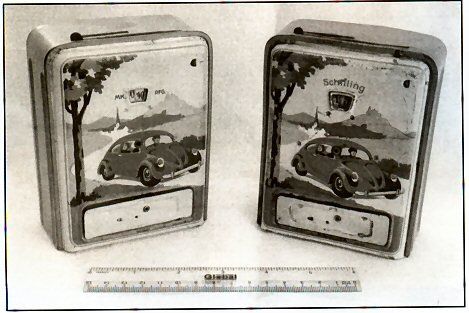
At first sight the two in the next photograph look identical, but if you look closely you will see that the counter on the one on the right is denominated in Schillings, and is therefore a rare example from Austria, which was of course annexed by Nazi Germany in 1938.
By now the instructions were printed on the base of the box, indicating that half or one schilling coins were accepted and that the lever should be pushed to the right. The door sprang open when the contents reached 50 schillings. The reverse of both these boxes is the same, showing a picnic party by a lake.
The last two are again almost identical, apart from slightly different colours, and by this time, probably 1939, they are called the 'Auto Sparkasse' (Car Savings Bank). The instructions are again printed on the base. The illustration on the back is another idyllic scene, this car also seeming to have more than a touch of a prototype about it, whilst that on the front is very much a KdF-Wagen.
By now the instructions were printed on the base of the box, indicating that half or one schilling coins were accepted and that the lever should be pushed to the right. The door sprang open when the contents reached 50 schillings. The reverse of both these boxes is the same, showing a picnic party by a lake.
The last two are again almost identical, apart from slightly different colours, and by this time, probably 1939, they are called the 'Auto Sparkasse' (Car Savings Bank). The instructions are again printed on the base. The illustration on the back is another idyllic scene, this car also seeming to have more than a touch of a prototype about it, whilst that on the front is very much a KdF-Wagen.
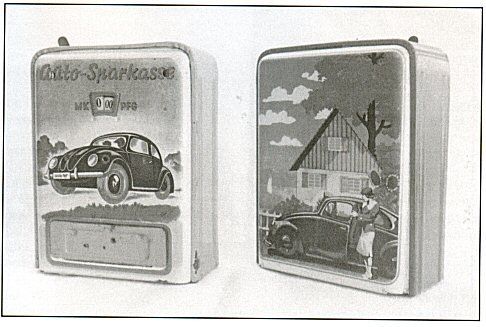
The last four boxes are stamped 'Geobra' on the base. This is a well-known German toy manufacturer, founded by Georg Brandstatter, the name of the Company coming from the first three letters of his Christian name and surname. The firm is still flourishing today, now being known as Geobra Brandstatter GmbH, and also coincidentally based in Zirndorf, like Michael Seidel, the makers of the first box. Geobra must have been making money boxes similar to the KdF Savings Boxes in the 1930's, as I have seen examples for sale. The design was then presumably adopted for the KdF boxes.
During the 1950's and 60's they produced various plastic toys, but then in the 1970's came the invention for which they are best known today, which is Playmobil. Those of you with young children will no doubt be familiar with the myriad plastic figures and models made by Playmobil, which must rival Lego in its popularity. Early examples are apparently highly collectable, but I find them hard to get excited about, whereas the Savings boxes, well, they are real collector's items in my opinion.
Brian Screaton
Back
During the 1950's and 60's they produced various plastic toys, but then in the 1970's came the invention for which they are best known today, which is Playmobil. Those of you with young children will no doubt be familiar with the myriad plastic figures and models made by Playmobil, which must rival Lego in its popularity. Early examples are apparently highly collectable, but I find them hard to get excited about, whereas the Savings boxes, well, they are real collector's items in my opinion.
Brian Screaton
